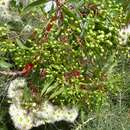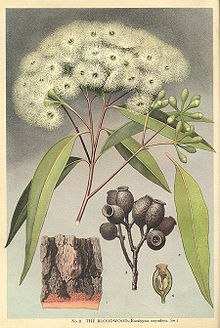pt-BR
nomes no trilho de navegação


Corymbia gummifera ist eine Pflanzenart aus der Gattung Corymbia innerhalb der Familie der Myrtengewächse (Myrtaceae). Sie kommt an der Ostküste Australiens, vom südöstlichen Queensland bis zum östlichen Victoria vor[1] und wird dort „Red Bloodwood“ genannt.[2]
Corymbia gummifera wächst als Baum, der Wuchshöhen bis 35 Metern erreicht.[3] Die Borke verbleibt an den kleineren Ästen oder auch am gesamten Baum, ist schachbrettartig und matt rotbraun bis grau-braun.[3] An den oberen Teilen des Baumes ist sie cremeweiß bis graun-braun und schält sich in kurzen Bändern. Die kleinen Zweige besitzen eine grüne Rinde. Im Mark sind Öldrüsen vorhanden, in der Borke nicht.[4]
Bei Corymbia gummifera liegt Heterophyllie vor. Die Laubblätter sind immer in Blattstiel und Blattspreite gegliedert. Die Blattspreite an jungen Exemplaren ist ei- bis kreisförmig[4] oder auch lanzettlich bis breit-lanzettlich und besitzt einfache Haare[3] und steife Drüsenhaare. An mittelalten Exemplaren ist die Blattspreite bei einer Länge von etwa 20 Zentimetern und einer Breite von etwa 0,7 Zentimetern lanzettlich bis breit-lanzettlich, gerade, ganzrandig und glänzend dunkelgrün. Der Blattstiel an erwachsenen Exemplaren ist bei einer Länge von 10 bis 23 mm schmal abgeflacht oder kanalförmig. Die Blattspreite an erwachsenen Exemplaren kann dünn oder auch relativ dick sein, ist bei einer Länge von 10 bis 16 Zentimetern und einer Breite von 2 bis 4 Zentimetern lanzettlich bis breit-lanzettlich, manchmal gebogen, mit sich verjüngender oder runder Spreitenbasis und spitzem oder bespitztem oberen Ende. Ihre Blattober- und -unterseite ist unterschiedlich glänzend oder matt grün. Die kaum erkennbaren Seitennerven gehen in geringen Abständen in einem stumpfen Winkel vom Mittelnerv ab. Auf jeder Blatthälfte gibt es einen ausgeprägten, durchgängigen, sogenannten Intramarginalnerv; er verläuft in geringem Abstand am Blattrand entlang. Die Keimblätter (Kotyledonen) sind fast kreisförmig.[4]
Endständig[4] auf einem bei einer Länge von 17 bis 30 mm im Querschnitt stielrunden Blütenstandsschaft steht ein zusammengesetzter Blütenstand, der aus doldigen Teilblütenständen mit jeweils etwa sieben Blüten besteht. Der Blütenstiel ist bei einer Länge von 9 bis 14 mm im Querschnitt stielrund.[4][3]
Die nicht blau-grün bemehlt oder bereifte Blütenknospe ist bei einer Länge von 9 bis 11 mm und einem Durchmesser von 5 bis 6 mm keulen- oder birnenförmig. Die Kelchblätter bilden eine Calyptra, die bis zur Blüte (Anthese) erhalten bleibt. Die glatte Calyptra ist halbkugelig oder konisch sowie leicht schnabelförmig, kürzer als der glatte Blütenbecher (Hypanthium) und so breit wie dieser.[3] Die Blüten sind weiß oder cremefarben.[4]
Die gestielte Frucht ist bei einer Länge von 12 bis 20 mm und einem Durchmesser von 5 bis 6 mm urnenförmig und drei- bis vierfächerig. Der Diskus ist eingedrückt, die Fruchtfächer sind eingeschlossen.[4][3]
Der regelmäßige und seitlich abgeflachte, kahnförmige Samen besitzt eine netzartige, matte bis seidenmatte, rotbraune Samenschale. Das Hilum befindet sich am oberen Ende des Samens.[4]
Das natürliche Verbreitungsgebiet von Corymbia gummifera ist die Ostküste Australiens vom Südosten Queenslands bis zum äußersten Osten Victorias, sowie das westlich daran angrenzende Tafelland im Osten und Nordosten von New South Wales.[1][4][3]
Corymbia gummifera gedeiht vorherrschend in trockenen Hartlaubwäldern oder lichtem Wald auf sandigen oder Sandsteinböden mit geringem Nährstoffgehalt.[4][3]
Die Erstveröffentlichung erfolgte 1788 durch Joseph Gärtner unter dem Namen (Basionym) Meterosideros gummifera Gaertn. in De Fructibus et Seminibus Plantarum, Volume 1, S. 170, Tafel 34, Figur 1. Das Typusmaterial weist die Beschriftung ex herbario Banksiano auf.[2] Die Neukombination zu Corymbia gummifera (Gaertn.) K.D.Hill & L.A.S.Johnson erfolgte 1995 unter dem Titel Systematic studies in the eucalypts. 7. A revision of the bloodwoods, genus Corymbia (Myrtaceae) in Telopea, Volume 6 (2–3), S. 233. Weitere Synonyme für Corymbia gummifera (Gaertn.) K.D.Hill & L.A.S.Johnson sind: Eucalyptus gummifera (Gaertn.) Hochr., Eucalyptus corymbosa Sm., Eucalyptus purpurascens var. petiolaris DC., Eucalyptus gummifera (Gaertn.) Hochr. var. gummifera, Eucalyptus corymbosa Sm. var. corymbosa, Eucalyptus corymbosus Cav. orth. var., Eucalyptus longifolia Link ex Maiden nom. inval., Eucalyptus oppositifolia Desf. nom. inval.[2][5][6]
Corymbia gummifera ist eine Pflanzenart aus der Gattung Corymbia innerhalb der Familie der Myrtengewächse (Myrtaceae). Sie kommt an der Ostküste Australiens, vom südöstlichen Queensland bis zum östlichen Victoria vor und wird dort „Red Bloodwood“ genannt.

Corymbia gummifera, commonly known as red bloodwood,[2] is a species of tree, rarely a mallee, that is endemic to eastern Australia. It has rough, tessellated bark on the trunk and branches, lance-shaped adult leaves, flower buds in groups of seven, creamy white flowers and urn-shaped fruit.
Corymbia gummifera is a tree that typically grows to a height of 20–35 m (66–115 ft), rarely a mallee, and forms a lignotuber. Young plants and coppice regrowth have leaves that are paler on the lower surface, egg-shaped to lance-shaped, 90–165 mm (3.5–6.5 in) long and 30–52 mm (1.2–2.0 in) wide, and petiolate. Juvenile leaves are opposite on the stem for a few pairs, then disjunct.[3] Adult leaves are glossy dark green, paler on the lower surface, lance-shaped, 55–160 mm (2.2–6.3 in) long and 15–50 mm (0.59–1.97 in) wide, tapering to a petiole 8–23 mm (0.31–0.91 in) long. The flower buds are arranged on the ends of branchlets on a branched peduncle 17–33 mm (0.67–1.30 in) long, each branch of the peduncle with seven buds on pedicels 2–15 mm (0.079–0.591 in) long. Mature buds are oval to pear-shaped, 8–12 mm (0.31–0.47 in) long and 4–6 mm (0.16–0.24 in) wide with a conical to rounded or slightly beaked operculum. Flowering occurs from December to June and the flowers are creamy white. The fruit is a woody urn-shaped capsule 12–22 mm (0.47–0.87 in) long and 9–18 mm (0.35–0.71 in) wide with the valves deeply enclosed in the fruit.[2][4][5][6]
The red bloodwood was first formally described in 1788 by Joseph Gaertner who gave it the name Metrosideros gummifera and published the description in his book De Fructibus et Seminibus Plantarum. (The name is often given as Metrosideros gummifera Sol. ex Gaertn., but Gaertner did not ascribe the name to Solander.)[6][7][8]
The name Eucalyptus corymbosa, published by James Edward Smith in his 1795 A Specimen of the Botany of New Holland,[9] is regarded as a synonym by the Australian Plant Census.[1] Eucalyptus corymbosus, published in 1797 by Cavanilles in his book Icones et Descriptiones Plantarum is an orthographical variant.[10][11] Eucalyptus oppositifolia, published in 1804 by Desfontaines is a nomen nudum because no description was provided.[12][13] Eucalyptus purpurascens var. petiolaris, published in 1828 by de Candolle is regarded as a synonym.[14] Eucalyptus longifolia, published in 1920 by Joseph Maiden is an invalid name because it had already been used for a different species.[15][16]
In 1995 Ken Hill and Lawrie Johnson changed the name to Corymbia gummifera.[6][17]
Corymbia gummifera mainly occurs on flats and low hills along the coast between the extreme eastern corner of Victoria and south-eastern Queensland. It grows best on moist, rich, loamy soil, but is also commonly found on poorer sandy soils.[2]
The heartwood of C. gummifera is very strong and durable, but has extensive gum lines. It is used for rough construction purposes, such as poles, sleepers, fencing and mining timbers.[2]
Corymbia gummifera may be used as a rootstock, onto which the ornamental C. ficifolia is grafted.[18]
 flower buds and flowers
flower buds and flowers  fruit
fruit  Illustration from a book by Joseph Maiden
Illustration from a book by Joseph Maiden Corymbia gummifera, commonly known as red bloodwood, is a species of tree, rarely a mallee, that is endemic to eastern Australia. It has rough, tessellated bark on the trunk and branches, lance-shaped adult leaves, flower buds in groups of seven, creamy white flowers and urn-shaped fruit.
Corymbia gummifera, comúnmente conocido como palo de sangre rojo (red bloodwood),[1] es un árbol de madera dura nativo del este de Australia.
Usualmente crece como un árbol, pero puede tomar la forma de un mallee en suelos muy pobres. Como árbol crece típicamente a una altura de 20 a 34 metros y un tronco con un diámetro de un metro. Sin embargo, árboles excepcionales pueden alcanzar 60 metros de alto y cuatro metros de diámetro. Tiene una corteza fibrosa típica de los bloodwoods, y hojas verde oscuras brillosas, de 10 a 14 centímetros de largo y 2–3.5 centímetros de ancho. Las flores salen en una inflorescencia de 3 a 7 umbelas.[2]
Crece principalmente en planicies y colinas bajas a lo largo de la costa entre la esquina extremo oriental del este de Victoria y el sureste de Queensland. Crece mejor en suelos húmedos, ricos y margosos, pero se le encuentra también en suelos arenosos más pobres.[2]
Su duramen es muy fuerte y resistente, pero tiene las clásicas extensivas líneas de gomero. Es usada para fines de construcción ruda, tales como postes, durmientes, cercas y material de minería.[2]
C. gummifera fue por primera vez publicada como Metrosideros gummifera por Joseph Gaertner en 1788. A pesar de esto, la especie fue the publicada como Eucalyptus corymbosa por James Edward Smith, como Eucalyptus corymbosus por Cavanilles en 1797, como Eucalyptus oppositifolia por Desfontaines en 1804, por Eucalyptus purpurascens var. petiolaris por de Candolle en 1828; y como Eucalyptus longifolia por Joseph Maiden en 1920. La precedencia de Metrosideros gummifera fue reconocida en 1925 por Hochreutiner, quien lo transfirió a Eucalyptus como Eucalyptus gummifera. En 1995, el género Eucalyptus fue dividido en tres géneros por K.D.Hill y L.A.S.Johnson, con E. gummifera transferido a Corymbia. Sin embargo algunos botánicos continúan reconociendo un solo género Eucalyptus sensu lato, y así mantuvieron el nombre Eucalyptus gummifera.[3]
Corymbia gummifera, comúnmente conocido como palo de sangre rojo (red bloodwood), es un árbol de madera dura nativo del este de Australia.
Corymbia gummifera est une espèce d'arbre de la famille des Myrtaceae endémique de l'est de l'Australie.
Il se présente généralement sous la forme d'un arbre, mais peut prendre la forme d'un mallee dans des sols très pauvres. Sous sa forme arborée, il se développe généralement jusqu'à une hauteur de 20 à 34 mètres et un diamètre de tronc d'un mètre. Cependant, les arbres peuvent exceptionnellement atteindre 60 mètres de haut et quatre mètres de diamètre. Il a une écorce fibreuse persistante, et des feuilles vert foncé brillant, de 10 à 14 centimètres de long pour 2 à 3,5 cm de large. Les fleurs forment une inflorescence de trois à sept ombelles[2].
C. gummifera a d'abord été publié en tant que Metrosideros gummifera par Joseph Gaertner en 1788. Malgré cela, l'espèce a été republiée comme Eucalyptus corymbosa par James Edward Smith dans son A Specimen of the Botany of New Holland (en) paru en 1793, puis comme Eucalyptus corymbosus par Cavanilles en 1797, comme Eucalyptus oppositifolia par Desfontaines en 1804, comme Eucalyptus purpurascens var. petiolaris par Candolle en 1828, et comme Eucalyptus longifolia par Joseph Maiden en 1920. L'antériorité de Metrosideros gummifera a été reconnue en 1925 par Hochreutiner (en), qui l'a transféré dans le genre Eucalyptus comme Eucalyptus gummifera.
En 1995, le genre Eucalyptus a été divisé en trois genres par K.D.Hill and L.A.S.Johnson, et E. gummifera a été transféré dans le genre Corymbia. Cependant, certains botanistes continuent de ne reconnaître qu'un seul genre, Eucalyptus, et conservent le nom Eucalyptus gummifera[3].
On le trouve principalement sur les plateaux de basse altitude le long de la côte entre l'extrémité nord-est du Victoria et le sud-est du Queensland. Il pousse mieux dans les sols riches et humides, mais peut également se trouver sur des sols sableux plus pauvres[2].
Corymbia gummifera est une espèce d'arbre de la famille des Myrtaceae endémique de l'est de l'Australie.
Corymbia gummifera, yang umumnya dikenal sebagai Kayu Darah Merah,[1] adalah sebuah pohon kayu keras yang berasal dari timur Australia.
Tumbuhan tersebut biasanya tumbuh sebagai sebuah pohon, namun dapat mengambil bentuk mallee di tanah yang sangat rendah.
C. gummifera pertama kali dipublikasikan sebagai Metrosideros gummifera oleh Joseph Gaertner pada 1788.
Corymbia gummifera, yang umumnya dikenal sebagai Kayu Darah Merah, adalah sebuah pohon kayu keras yang berasal dari timur Australia.
Corymbia gummifera là một loài thực vật có hoa trong Họ Đào kim nương. Loài này được (Gaertn.) K.D.Hill & L.A.S.Johnson mô tả khoa học đầu tiên năm 1995.[1]
Corymbia gummifera là một loài thực vật có hoa trong Họ Đào kim nương. Loài này được (Gaertn.) K.D.Hill & L.A.S.Johnson mô tả khoa học đầu tiên năm 1995.